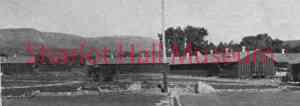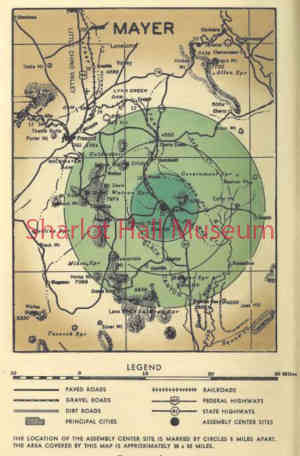By Worcester P. Bong
In December 1941, the United States entered World War II to join Allied forces in fighting Germany, Italy and Japan. In the early months of the war, the little-known town of Mayer, Arizona had a small but significant role.
 On February 19, 1942, President Franklin Roosevelt issued Executive Order 9066, authorizing the evacuation and internment of all persons from the West Coast deemed a threat to national security to internment centers further inland. The order gave the military broad powers to ban any citizen from the restricted zone known as Military Area 1, which encompassed the western half of Washington and Oregon, the southern half of Arizona, the western half of California from the Oregon border to Los Angeles and everything south of Los Angeles. The remainder of the U.S. made up Military Area 2.
On February 19, 1942, President Franklin Roosevelt issued Executive Order 9066, authorizing the evacuation and internment of all persons from the West Coast deemed a threat to national security to internment centers further inland. The order gave the military broad powers to ban any citizen from the restricted zone known as Military Area 1, which encompassed the western half of Washington and Oregon, the southern half of Arizona, the western half of California from the Oregon border to Los Angeles and everything south of Los Angeles. The remainder of the U.S. made up Military Area 2.
Public proclamations enacted under the executive order confined Japanese Americans to a 5-mile radius from their home and instituted a curfew from 8:00 p.m. to 6:00 a.m. By mid-March Japanese Americans and Japanese immigrants living in Military Area 1 were perceived as too dangerous to go about daily business. The military decided it needed temporary detention assembly centers to house them until internment centers could be completed. A civilian organization called the War Relocation Authority was created for this purpose.
During April 1942, sixteen temporary detention assembly centers were established -- nine at fairgrounds, two at horse racetracks (Santa Anita and Tanforan, California), two at migrant workers camps (Marysville and Sacramento, California), one at a livestock exposition hall (Portland, Oregon), one at a mill site (Pinedale, California) and one at an abandoned Civilian Conservation Corps (CCC) camp (Mayer, Arizona). Another assembly center was to be established in Cave Creek but was deemed unneeded. The forced removal and internment of over 110,000 American citizens of Japanese ancestry and Japanese immigrants began.
 Mayer is located 28 miles southeast of Prescott on State Highway 69. The assembly center was established at the abandoned CCC camp. Civilian Exclusion Order Number 38 required that internees from southern Arizona (Maricopa, Pima and Yuma Counties) be transported and processed at this assembly center. The majority were from Glendale and Mesa along the Salt River Valley.
Mayer is located 28 miles southeast of Prescott on State Highway 69. The assembly center was established at the abandoned CCC camp. Civilian Exclusion Order Number 38 required that internees from southern Arizona (Maricopa, Pima and Yuma Counties) be transported and processed at this assembly center. The majority were from Glendale and Mesa along the Salt River Valley.
The May 4, 1942 edition of the Prescott Evening Courier reported that internees had to register and evacuate their homes and property by May 8th. Many of them had to dispose of land, businesses and property. They could bring only bedding, clothing, tableware and essential personal effects. The May 8, 1942 edition of the Prescott Evening Courier reported that 172 internees were transported by buses to the Mayer site that day, with eleven arriving the day before. The article reported “many internees expressed loyalty to the United States and exhibited war bonds purchased with proceeds from the sale of their property”.
 The Mayer Assembly Center, the smallest of the centers, was occupied for only 27 days (May 7 to June 2, 1942). Despite the barbed wire and armed guards, internees made the best of their accommodations, holding church services, starting vegetable gardens and constructing a recreational facility. In total, 245 internees (90% were American-born of Japanese ancestry) were confined there. They were moved on June 2, 1942 to the Poston (Colorado River) Incarceration Center near Parker and the Mayer Assembly Center was closed. After World War II, despite lingering hostile discrimination and bitter attitudes towards Japanese Americans citizens, many internees returned to the same communities to re-build their lives and re-establish successful farms and businesses.
The Mayer Assembly Center, the smallest of the centers, was occupied for only 27 days (May 7 to June 2, 1942). Despite the barbed wire and armed guards, internees made the best of their accommodations, holding church services, starting vegetable gardens and constructing a recreational facility. In total, 245 internees (90% were American-born of Japanese ancestry) were confined there. They were moved on June 2, 1942 to the Poston (Colorado River) Incarceration Center near Parker and the Mayer Assembly Center was closed. After World War II, despite lingering hostile discrimination and bitter attitudes towards Japanese Americans citizens, many internees returned to the same communities to re-build their lives and re-establish successful farms and businesses.
Today, nothing remains of the Mayer Assembly Center. Construction of State Highway 69 and stores, restaurants and other businesses along Central Avenue in Mayer have obliterated all traces of it, but the hardships that those interned Japanese American citizens endured should always be remembered.
“Days Past” is a collaborative project of the Sharlot Hall Museum and the Prescott Corral of Westerners International (www.prescottcorral.org). This and other Days Past articles are also available at archives.sharlothallmuseum.org/articles/days-past-articles/1. The public is encouraged to submit proposed articles and inquiries to dayspast@sharlothallmuseum.org. Please contact SHM Research Center reference desk at 928-445-3122 Ext. 2, or via email at archivesrequest@sharlothallmuseum.org for information or assistance with photo requests.


